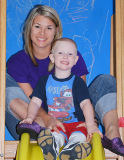 picture of the Cunningham Twins compliments of Sarah Pope Photography
picture of the Cunningham Twins compliments of Sarah Pope Photography
What is torticollis?
Congenital Muscular Torticollis (CMT) becomes evident shortly after birth. A key muscle in the baby’s neck is tighter on one side of the neck than the other side. This causes restriction of movement of the baby’s head. CMT can be caused by many different factors including the baby’s position in utero, injury during delivery and/or underlying musculoskeletal pathology. The exact cause is often unknown.
Congenital Muscular Torticollis (CMT) becomes evident shortly after birth. A key muscle in the baby’s neck is tighter on one side of the neck than the other side. This causes restriction of movement of the baby’s head. CMT can be caused by many different factors including the baby’s position in utero, injury during delivery and/or underlying musculoskeletal pathology. The exact cause is often unknown.
What might cause a parent to suspect torticollis in their infant?
Parents can carefully observe their baby’s preferred head position. Does the baby’s head seem to regularly tilt to one side, with an ear being closer to one shoulder as compared to the opposite shoulder? Parents can also observe their child’s movement. Does the baby tend to prefer to rotate their head and look to one side consistently rather than looking to both sides equally? Finally, parents can also observe their baby’s head shape. Does the back of the baby’s head appear to be flat? Do the baby’s facial features appear to be asymmetrical?
Parents can carefully observe their baby’s preferred head position. Does the baby’s head seem to regularly tilt to one side, with an ear being closer to one shoulder as compared to the opposite shoulder? Parents can also observe their child’s movement. Does the baby tend to prefer to rotate their head and look to one side consistently rather than looking to both sides equally? Finally, parents can also observe their baby’s head shape. Does the back of the baby’s head appear to be flat? Do the baby’s facial features appear to be asymmetrical?
Can torticollis resolve on its own without treatment?
If left untreated, torticollis is likely to worsen and may lead to further complications. The child may develop a strong preference to use and move to one side of the body more than the other. This can result in scoliosis, difficulty with balance, and possibly a negative effect on the visual field. Significant flattening on one side of the head or face (plagiocephaly) could result in the need to use a cranial shaping helmet for correction. When a baby is unable to freely turn her head to see, hear and interact with her surroundings, then her cognitive development may also be delayed.
If left untreated, torticollis is likely to worsen and may lead to further complications. The child may develop a strong preference to use and move to one side of the body more than the other. This can result in scoliosis, difficulty with balance, and possibly a negative effect on the visual field. Significant flattening on one side of the head or face (plagiocephaly) could result in the need to use a cranial shaping helmet for correction. When a baby is unable to freely turn her head to see, hear and interact with her surroundings, then her cognitive development may also be delayed.
What is the best time to offer treatment?
The earlier the better! Referral to the pediatrician and physical therapist when the very first concern arises is crucial. The Pediatric Section of the American Physical Therapy Association has shared some remarkable numbers related to the effectiveness of early intervention. For example, they have noted that if treatment is started before 1 month of age, 98% of babies achieve near normal range within 1.5 months, but waiting until after 1 month of age prolongs intervention to about 6 months. Waiting until after 6 months can require 9 to 10 months of intervention, with progressively fewer infants achieving a near normal range of motion.
The earlier the better! Referral to the pediatrician and physical therapist when the very first concern arises is crucial. The Pediatric Section of the American Physical Therapy Association has shared some remarkable numbers related to the effectiveness of early intervention. For example, they have noted that if treatment is started before 1 month of age, 98% of babies achieve near normal range within 1.5 months, but waiting until after 1 month of age prolongs intervention to about 6 months. Waiting until after 6 months can require 9 to 10 months of intervention, with progressively fewer infants achieving a near normal range of motion.
How can therapy help?
Physical therapists provide parents and caregivers with training and education regarding immediate implementation of correct positioning at home and improper use of baby equipment that may actually be worsening the symptoms. Therapists develop daily exercise and stretching programs specifically for the child's level of impairment.
Physical therapists provide parents and caregivers with training and education regarding immediate implementation of correct positioning at home and improper use of baby equipment that may actually be worsening the symptoms. Therapists develop daily exercise and stretching programs specifically for the child's level of impairment.
Danielle Cunningham's interview "Shedding a Light on Torticollis" is featured in the August 2016 edition of Peekaboo Magazine and the NWA Kid's Directory. Danielle completed her bachelor's of science at Texas Woman’s University. She went on to receive her Doctorate in Physical Therapy from UCA in 2008. She pursued post-graduate work in rehab with neurologically impaired patients before joining the Children’s Therapy TEAM family in 2009. Danielle serves as Coordinator of Clinical Education in Physical Therapy at Children’s Therapy TEAM. In 2011, Danielle served internationally with TEAMworks Therapists in Ukraine. She continues to be an active supporter of TEAMworks outreach. Danielle and her husband live in Rogers, Arkansas and have three young children. Danielle gave birth to twins in 2015, so she and her husband fondly call their home-life busy.


